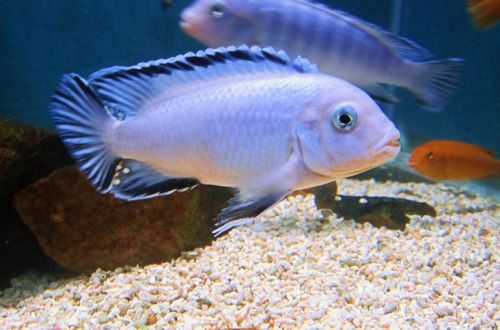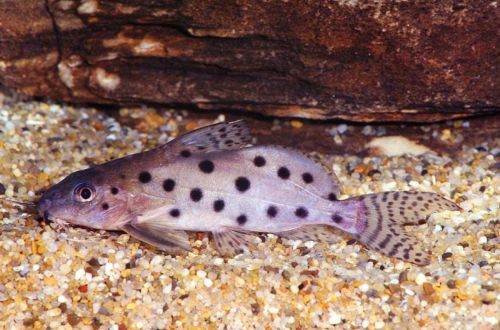
Barbus oligolepis
Oligolepis Barb or Checkered Barb, scientific name Oliotius oligolepis, belongs to the Cyprinidae family. A popular aquarium fish, easy to keep and unpretentious, perfectly compatible with many other well-known species.

Contents
Habitat
It is endemic to the island of Sumatra, lives in Lake Meninju – the caldera of a volcano that once exploded, and possibly in tributary rivers, but the extent of its distribution remains unknown. Currently, all fish for sale are commercially farmed and are not sourced from the wild.
Requirements and conditions:
- The volume of the aquarium – from 60 liters.
- The size of the fish is up to 4.5 cm.
- Temperature – 20-25°C
- Value pH — 6.0–7.5
- Water hardness – soft to medium hard (2-12dGH)
- Substrate type – any dark
- Lighting – subdued
- Brackish water – no
- Water movement is weak
- Meals – any
- Temperament – peaceful
- Flock content from 8-10 individuals
- Incompatible with large species
Description
One of the smallest barbs, adults reach only 4 cm in length, and this applies primarily to females, males are noticeably smaller, but compensate for this with a bright and rich body color. The main color is closer to pink with a metallic tint, the scales have dark blotches that form a mesh pattern. The fins are red with dark edging.
Food
They accept all types of dry, frozen and live food. The basis of the diet is protein food (bloodworm, daphnia and other crustaceans) in combination with some dry food with herbal supplements. Feed 2-3 times a day in the amount eaten in 5 minutes, all food residues should be removed from the aquarium to avoid water pollution.
Maintenance and care, arrangement of the aquarium
Checkered Barbus is very unpretentious, a flock of 8-10 individuals can be content with a tank of 60 liters or more, designed to your taste, but subject to certain conditions. It is recommended to use a dark substrate to bring out the coloration of the fish, and a few floating plants as a natural means of shading the aquarium. Adding various kinds of shelters (driftwood, branches and tree roots) will also blow to the place.
The minimum set of equipment is standard and consists of a filter, a heater, an aerator and a low power lighting system, since the fish prefer subdued light.
When keeping barbs, pay the main attention to the quality of water, it should be updated weekly by 25-30% of the volume and avoid high concentrations of organic waste (food leftovers, excrement, fallen plant fragments, etc.), by timely cleaning the soil with a siphon.
Behavior and Compatibility
Peaceful active schooling fish, prefers to stay in a group of 8-10 individuals. This not only makes them less shy, but also significantly improves the coloration, in particular in males, which are forced to compete among themselves for the attention of females. Compatible with many similar in size and temperament species from among the cyprinids, characins, viviparous and some catfish.
Breeding / breeding
Refers to spawning species. In a home aquarium, spawning can occur at any time of the year. Females spawn near the surface of the water near clusters of plants, and males at this moment fertilize it, then the eggs are left to themselves. Barbs have poorly developed parental instincts, so they can eat their own caviar immediately after spawning.
If there is a need to preserve offspring, then it is more expedient to breed in a separate tank – a spawning aquarium. It uses several floating small-leaved plants, for example, fir-tree pinifolia, light green hornwort, floating riccia and the like. The eggs get stuck in this dense plant network and find themselves in relative safety. To save eggs that have fallen to the bottom, coarse soil with large spaces between particles is used, for example, pebbles, decorative glass beads. These voids act as an emergency shelter. Of the equipment, a heater, an aerator, a low-power lamp and a simple sponge filter should be used. It is filled with water from the general aquarium.
When you notice that the females have become noticeably rounded, and the males have begun to actively show attention to their chosen ones, then the mating season has begun and it is time to move the future parents to a separate aquarium. One pair can produce up to 300 eggs; at the end of spawning, the fish are returned back. The fry appear after 24–28 hours, and begin to swim freely after another day. Feed with specialized microfood, which is recommended to be purchased at pet stores.
Fish diseases
A balanced aquarium ecosystem with suitable conditions for a particular species and proper nutrition are the best guarantee against the occurrence of various kinds of diseases. Diseases, as a rule, are only a consequence of an unsatisfactory state of the environment, and this must be dealt with first of all. However, it is also useful to know the treatment methods and symptoms of common diseases, more about them in the section “Diseases of aquarium fish”.





